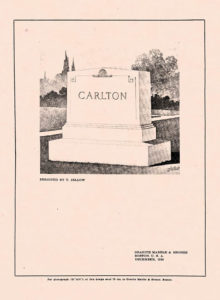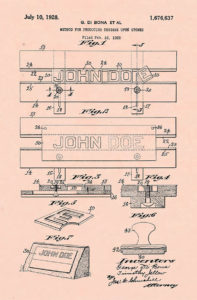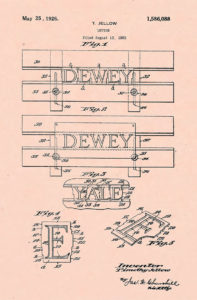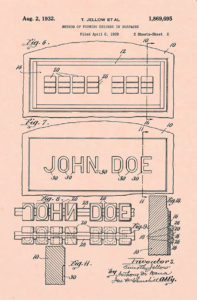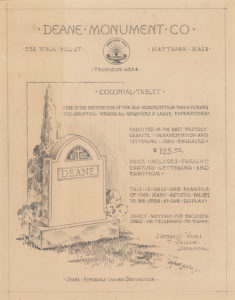Timothy Jellow
1891 – 1932
Timothy Jellow was a memorial draftsman, lettering specialist, inventor, and founding partner of the Spacerite Company along with Antonio “George” Di Bona.
Timothy was born in 1891 in Mulgrave, Nova Scotia, Canada, and by 1892 his family moved to Massachusetts in the United States. After high school, he attended art school in Boston, and on August 28 of 1915, was married to Helen Hartley Kenney of Charlestown. Helen was one of the children of John H. Kenney, owner of a bakery on Bunker Hill St.
Jellow worked for many manufacturers during his career, which was common for a draftsman at that time. One such company was the Deane Monument Company of Mattapan, Massachusetts. He quickly became well-known as a draftsman, and particularly for his lettering. Between 1918 and 1920 Jellow had several designs published in issues of the trade magazine Granite Marble and Bronze, and in 1929 he worked as a consultant in charge of the scale and design of the lettering for a soldier’s memorial erected by the city of Milford, New Hampshire. Jellow received the bulk of his success with George Di Bona as a founding partner of the Spacerite lettering system beginning in 1925. Timothy invented the idea for the system–which consisted of metal letters and a wood rack for laying out inscriptions with proper spacing–and brought the idea to Di Bona, a stone carver and letterer. The brilliance of the invention was including the “contact keys” on the side of the metal letters that forced proper spacing. Together the two men set up a shop in Quincy to work on finalizing the system, and later according to the city’s 1926 Inaugural Address were together granted permission for the creation of the new streets of Alton Road, Madison Avenue, Dale Avenue, and Crest Street. The reason for the partners’ interest in the construction of the streets is unknown.
Jellow designed the first three Spacerite alphabets, which were released together in 1925, and was also likely in charge of adapting the company’s fourth alphabet from an Old English designed by Thomas French. These four alphabets are the Spacerite Classic Roman, Spacerite Modified Roman, Spacerite Round Corner Gothic, and Spacerite Old English. The first three of the alphabets were created before Jellow’s death in 1932, while the exact year of creation of the Old English is still in question. The company would go on to produce a total of 17 different alphabets, 2 sets of alternate numerals, and nearly two dozen emblems and design elements.
Jellow received four patents during his lifetime, all relating to methods of speeding up the layout and sandblast process of inscriptions on monuments. The first two of the patents being for the Spacerite Company. Jellow and Di Bona applied for their first patent for the Spacerite lettering process in February 1925, and Jellow himself submitted a second application for the spacing process in August of the same year–assigning one-half of the patent to George Di Bona. The two began production of the metal alphabets and layout rack system in 1925 and received patent approval for Jellow’s second application in 1926. For reasons unknown, the first application would be approved much later, in 1928. The process was wildly successful, and many manufacturers still use it today, even in the face of other physical and digital technologies that have increased the simplicity and speed of creating layouts ready for sandblasting.
Jellow continued his penchant for invention, applying for two more patents pertaining to preparing lettering and designs for sandblasting in 1929 and 1931. It is unclear as to whether either of these solutions was ever marketed to the industry, as no evidence of their production or use is known at this time. Unlike the Spacerite system, both of the processes for Jellow’s later patents included utilizing letters made of plaster-like material which would be pressed into a pre-heated stencil but would be destroyed by the sandblast process. While the new patents aimed to speed up the process by removing the need for hand-cutting the stencil, the destruction of the lettering added complexity and was a step backward in ease and reproducibility. Jellow’s final patent was approved in 1933 after his death and was assigned to his wife.
Deane Monument Company where Jellow once worked in Mattapan, later moved to Roslindale, Massachusetts, and was eventually purchased by Davis Monuments sometime after the 1980s. The company found an original drawing for a Deane Monument Co. advertisement drafted by Jellow and gifted it to his granddaughter who was researching family history at the time. The date of the drawing is unknown, but it is likely from the early to mid-1920s.
Timothy Jellow is buried at Mt. Wollaston Cemetery in Quincy, though his grave has no stone. Unfortunately, the man who helped create the system responsible for lettering the majority of memorials in North America during the 20th century does not have a memorial of his own. The Monument Lettering Center is still in the process of researching information related to Mr. Jellow’s life and work. According to family members, no known photos of Mr. Jellow exist. If you are aware of any photos or historical information involving Timothy Jellow, please contact the MLC.
The MLC would like to offer a special thanks to Timothy Jellow’s granddaughter, Barbara Haines, for her help with much of the family history in this article, as well as the use of Timothy’s Deane Monument Co. sketch.

